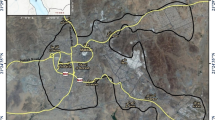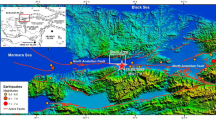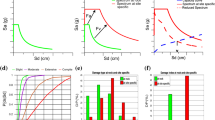Abstract
The seismic vulnerability index (Kg) is a parameter that depends on the dynamic properties of soil. With this parameter, it is possible to evaluate the vulnerability of a point-based site under strong ground motion. Since it is related to the natural vibration period and amplification factor, the parameter can be calculated for both soil and structure. In this study, HVSR microtremor measurements are recorded at more than 200 points in the Van region to generate a seismic vulnerability index map. After generating the map, it is determined that the hazard potential and seismic vulnerability index is high at the sites close to Van Lake and at the densely populated city center. Damage information of the buildings investigated after the 2011 Van earthquakes (Mw = 7.1) are placed on the seismic vulnerability index map and it is realized that there may be a correlation between the damage and the seismic vulnerability index. There is a high correlation, approximately 80 percent, between the damage rate map based on the damaged building data and the Kg values. In addition, vulnerability indexes of buildings are calculated and the eff ect of local soil conditions and building properties on the damage levels are determined. From the results of this study and the site observations after the 2011 Van earthquakes, it is found that structural damage is not only structure-dependent but is also related to the dynamic behavior of soil layers and local soil conditions.
Similar content being viewed by others
References
AFAD, Disaster & Emergency Management Authority of Turkey, Available: https://www.afad.gov.tr/.
Akansel V, Ameri G, Askan A, Caner A, Erdil B, Kale Ö and Okuyucu D (2014), “The 23 October 2011 Mw = 7.0 Van (Eastern Turkey) Earthquake: Interpretations of Recorded Strong Ground Motions and Post-Earthquake Conditions of Nearby Structures,” Earthquake Spectra, 30(2): 657–682.
Akın Ö and Sayıl N (2016), “Site Characterization Using Surface Wave Methods in the Arsin-Trabzon Province, NE Turkey,” Environ Earth Sci., 75: 72, DOI 10.1007/s12665-015-4840-6.
Akkaya İ (2015), “The Application of HVSR Microtremor Survey Method in Yüksekova (Hakkari) Region, Eastern Turkey,” Journal of African Earth Sciences, 109: 87–95.
Akkaya İ, Özvan A, Tapan M and Şengül MA (2015), “Determining the Site Eff ects of 23 October 2011 Earthquake (Van province, Turkey) on the Rural Areas Using HVSR Microtremor Method,” Journal of Earth System Science, 124(7): 1429–1443.
Akkaya İ, Özvan A, Akın M, Akın MK, and Övün U (2017), “Kayma Dalgası Hızı (Vs) Kullanılarak Erciş (Van) Yerleşim Alanının Sıvılaşma Potansiyelinin Değerlendirilmesi,” Çukurova Üniversitesi Mühendislik Mimarlık Fakültesi Dergisi, 32(3): 55–68. (in Turkish)
Akkaya İ, Özvan A, Akın M, Akın MK, and Övün U (2018a), “Comparison of SPT and Vs-Based Liquefaction Analyses: A Case Study in Erciş (Van, Turkey),” Acta Geophysica, 66: 21–38. https://doi.org/10.1007/s11600-017-0103-0.
Akkaya İ, Özvan A and Tapan M (2018b), “Determination of Dynamic Characteristics of Quaternary Soils and Local Soil Conditions in Van and Surroundings by Geophysical Methods,” The Scientific Research Projects Office of Van Yuzuncu Yil University Project Number 2015-MIM-B259, 138 pages.
Akkaya İ and Özvan A (2019), “Site Characterization in the Van Settlement (Eastern Turkey) Using Surface Waves and HVSR Microtremor Methods,” Journal of Applied Geophysics, 160: 157–170.
Ambraseys NN and Finkel CF (1995), The Seismicity of Turkey and Adjacent Areas: A Historical Review, 1500–1800, İstanbul: Eren publishing & booktrade.
Ambraseys NN (2001), “Reassessment of Earthquakes 1900–1999 in the Eastern Mediterranean and Middle East.,” Geophys. J. Int., 145: 471–485.
Ansal A (1999a), “Strong Ground Motions and Site Amplification. Theme Lecture,” 2nd Int. Conf. on Earthquake Geotechnical Engineering, 3: 879–894, Ed. P.S. Pinto, Balkema, Rotterdam.
Ansal A (1999b), “The Cyclic Behavior of Soils and Eff ects of Geotechnical Factors During 17 August 1999 Kocaeli Earthquake,” Earthquake Hazard and Risk in the Mediterranean Region, Nicosia, 1: 89–104.
Bard PY (1998), “Microtremor Measurements: A Tool for Site Eff ect Estimation,” Proceedings of 2nd International Symposium on the Eff ect of Surface Geology on Seismic Motion, 1–3 Dec, Yokohama, Japan, 3: 1251–1279.
Bayraktar A, Altunisik A, Türker T, Karadeniz H, Erdogdu S, Angin Z and Özsahin T (2014), “Structural Performance Evaluation of 90 RC Buildings Collapsed during the 2011 Van, Turkey, Earthquakes,” J. Perform. Constr. Facil., 10.1061/(ASCE)CF.1943-5509.0000524, 04014177.
Birgören G, Ozel O and Siyahi B (2009), “Bedrock Depth Mapping of the Coast South of Istanbul: Comparison of Analytical and Experimental Analyses,” Turkish Journal of Earth Sciences, 18: 315–329.
Bonnefoy-Claudet S, Cotton F and Bard PY (2006), “The Nature of Noise Wavefield and Its Applications for Site Eff ects Studies: A Literature Review,” Earth-Science Reviews, 79: 205–227.
Bozkurt E (2001), “Neotectonics of Turkey-a Synthesis,” Geodinamica Acta, 14: 3–30.
Claprood M, Asten M and Kristek J (2012), “Combining HVSR Microtremor Observations with the SPAC Method for Site Resonance Study of the Tamar Valley in Launceston (Tasmania, Australia),” Geophysical Journal International, 191: 765–780.
Cukur D, Krastel S, Tomonaga Y, Schmincke H-U, Sumita M, Meydan AF, Cagatay MN, Toker M, Kim S-P, Kong G-S and Horozal S (2016), “Structural Characteristics of the Lake Van Basin, Eastern Turkey, from High-Resolution Seismic Reflection Profiles and Multibeam Echosounder Data: Geologic and Tectonic Implications,” Int. J. Earth Sci. (Geol Rundsch), http:// dx.doi.org/10.1007/s00531-016-1312-5.
Delgado J, Lopez Casado C, Giner J, Estevez A, Cuenca A and Molina S (2000), “Microtremors as a Geophysical Exploration Tool: Applications and Limitations,” Pure and Applied Geophysics, 157: 1445–1462.
Dikmen Ü and Mirzaoğlu M (2005), “The Seismic Microzonation Map of Yenisehir-Bursa, NW of Turkey by Means of Ambient Noise Measurements,” Balkan Geophysical Society, 8(2): 53–62.
Dindar H, Dimililer K, Özdağ ÖC, Atalar C, Akgün M and Özyankı A (2017), “Vulnerability Index Assessment Using Neural Networks (VIANN): A Case Study of Nicosia, Cyprus,” ISPRS Annals of the Photogrammetry, Remote Sensing and Spatial Information Sciences, Volume IV-4/W4, 2017 4th International GeoAdvances Workshop, 14–15 October 2017, Safranbolu, Karabuk, Turkey.
Emre Ö, Duman TY, Özalp S, Elmacı H, Olgun Ş and Şaroğlu F (2013), “1/1.250.000 Ölçekli Türkiye Diri Fay Haritası,” Maden Tetkik ve Arama Genel Müdürlüğü Özel Yayınlar Serisi, Ankara, Türkiye. (in Turkish)
Erdil B (2017), “Why RC Buildings Failed in the 2011 Van, Turkey, Earthquakes: Construction Versus Design Practices,” Journal of Performance of Constructed Facilities, 31(3): doi.org/10.1061/(ASCE)CF.1943-5509.0000980.
Erdil B and Ceylan H (2019a), “MVP Interaction Based Seismic Vulnerability Assessment of RC Buildings,” Gradevinar, 71: 489–503.
Erdil B and Ceylan H (2019b), “A Detailed Comparison of Preliminary Seismic Vulnerability Assessment Methods for RC Buildings,” Iranian Journal of Science and Technology-Transactions of Civil Engineering, 43:711–725.
Eskişar T, Özyalın Ş, Kuruoğlu M and Yılmaz HR (2013), “Microtremor Measurements in the Northern Coast of İzmir Bay, Turkey to Evaluate Site-Specific Characteristics and Fundamental Periods by H/V Spectral Ratio Method,” J. Earth Syst. Sci., 122(1): 123–136.
Fah D, Kind F and Giardini D (2001), “A Theoretical Investigation of Average H/V Ratios,” Geophysical Journal International, 145: 535–549.
Field EH and Jacob KH (1993), “The Theoretical Response of Sedimentary Layers to Ambient Seismic Noise,” Geophys Res Lett, 20–24: 2925–2928.
Field EH and Jacob KH (1995), “A Comparison and Test of Various Site-Response Estimation Techniques, Including Three That are not Reference-Site Dependent,” Bull. Seismol. Soc. Am., 85(4): 1127–1143.
Gallipoli MR, Mucciarelli M, Gallicchio S, Tropeano M and Lizza C (2004), “Horizontal to Vertical Spectral Ratio (HVSR) Measurements in the Area Damaged by the 2002 Molise, Italy, Earthquake,” Earthq Spectra, 20(S1): S81–S93.
Gallipoli MR and Mucciarelli M (2009), “Comparison of Site Classification from VS30, VS10, and HVSR in Italy,” Bull Seismol Soc Am, 99: 340–351.
GEOPSY (1997), Geophysical Signal Database for Noise Array Processing, http://www.geopsy.org, Accessed June 2015.
Gitterman Y, Zaslavsky Y, Shapira A and Shtivelman V (1996), “Empirical Site Response Evaluations: Case Studies in Israel,” Soil Dynamics Earthquake Engineering, 15: 447–463.
Ishihara K (1982), “Evaluation of Soil Properties for Use in Earthquake Response Analysis,” Proc. International Symp. On Num. Model in Geomechanics, 237–259.
Koçyiğit A, Yilmaz A, Adamia S and Kulashvili S (2001), “Neotectonics of East Anatolian Plateau (Turkey) and Lesser Caucasus: Implication for Transition from Thrusting to Strike-Slip Faulting,” Geodinamica Acta, 14: 177–195.
Koçyiğit A (2013), “New Field and Seismic Data about the Intraplate Strike-Slip Deformation in Van Region, East Anatolian Plateau, E.Turkey,” Journal of Asian Eart Sciences, 62: 586–605.
KOERI (2011), “Probabilistic Assessment of the Seismic Hazard for the Lake Van basin, October, 23 2011,” http://www.koeri.boun.edu.tr, Accessed 23 Dec 2012.
KOERI, Bogazici University Kandilli Observatory and Earthquake Research Institute Regional Earthquake-Tsunami Monitoring Center (KOERI) website, Available: http://www.koeri.boun.edu.tr/sismo/2/en/.
Konno K and Ohmachi T (1998), “Ground-Motion Characteristics Estimated from Spectral Ratio Between Horizontal and Vertical Components of Microtremor,” Bulletin of the Seismological Society of America, 88: 228–241.
Lachet C and Bard PY (1994), “Numerical and Theoretical Investigations on the Possibilities and Limitations of Nakamura’s Technique,” Journal of Physics of the Earth, 42: 377–397.
Lermo J and Chavez-Garcia FJ (1993), “Site Eff ect Evaluation Using Spectral Ratios with Only One Station,” Bulletin of the Seismological Society of America, 83: 1574–1594.
Lermo J and Chavez-Garcia FJ (1994), “Are Microtremors Useful in Site Response Evaluation?” Bulletin of the Seismological Society of America, 84: 1350–1364.
Livaoğlu H, Irmak TS and Güven IT (2017), “Seismic Vulnerability Indices of Ground for Değirmendere (Kocaeli Province, Turkey),” Bull Eng Geol Environ, DOI 10.1007/s10064-017-1102-8.
Mucciarelli M (1998), “Reliability and Applicability of Nakamura’s Technique Using Microtremors: An Experimental Approach,” Journal of Earthquake Engineering, 2: 1–14.
Nakamura Y (1989), “A Method for Dynamic Characteristics Estimation of Subsurface Using Microtremor on the Ground Surface,” QR of RTRI, 30: 25–33.
Nakamura Y (1997), Seismic Vulnerability Indices for Ground and Structures Using Microtremor, World Congress on Railway Research, Florence.
Nakamura Y (2000), “Clear Identification of the Fundamental Idea of Nakamura’s Technique and Its Applications,” In: 12th World Conference on Earthquake Engineering, New Zealand (CD-ROM), Paper No. 2656.
Nakamura Y (2008), “On the H/V Spectrum,” The 14th World Conference on Earthquake Engineering, Beijing, China.
Nath SK, Adhikari MD, Devaraj N and Maiti SK (2015), “Seismic Vulnerability and Risk Assessment of Kolkata City, India,” Nat. Hazards Earth Syst. Sci., 15: 1103–1121.
NEHRP (1997), Recommended Provisions For Seismic Regulations For New Buildings and Other Structures, FEMA-303, Prepared by the Building Seismic Safety Council for the Federal Emergency Management Agency, Washington, DC.
Okada H (2003), The Microtremor Survey Method, Geophysical Monograph, No. 12, Society of Exploration Geophysicists, Tulsa.
Özvan A, Akkaya İ, Tapan M and Şengül MA (2005), “Van Yerleşkesinin Deprem Tehlikesi ve Olası bir Depremin Sonuçları,” Deprem Sempozyumu Kocaeli 2005, 23–25 Mart 2005, Kocaeli. (in Turkish)
Özalaybey S, Zor E, Ergintav S and Tapırdamaz MC (2011), “Investigation of 3‐D Basin Structures in the İzmit Bay Area (Turkey) by Singlestation Microtremor and Gravimetric Methods,” Geophysical Journal International, 186: 883–894.
Pamuk E, Özdağ CÖ, Tucçel A, Özyalın Ş and Akgün M (2017a), “Using HVSR (Nakamura technique) and MASW methods,” Nat Hazards, DOI 10.1007/s11069-017-3077-y.
Pamuk E, Akgün M, Özdağ ÖC and Gönenç T (2017b), “2D Soil and Engineering-Seismic Bedrock Modeling of Eastern Part of Izmir Inner Bay/Turkey,” Journal of Applied Geophysics, 137: 104–117.
Pamuk E, Özdağ ÖC, Özyalın Ş and Akgün M (2017c), “Soil Characterization of Tınaztepe Region (İzmir/ Turkey) Using Surface Wave Methods and Nakamura (HVSR) Technique,” Earthquake Engineering and Engineering Vibration, 16(2): 447–458.
Paudyal YR, Yatabe R, Bhandary NP, and Dahal RK (2012), “A Study of Local Amplification Eff ect of Soil Layers on Ground Motion in the Kathmandu Valley Using Microtremor Analysis,” Earthquake Engineering and Engineering Vibration, 11: 257–268.
Saatcioglu M, Mitchell D, Tinawi R, Gardner NJ, Gillies AG, Ghobarah A, Anderson DL and Lau D (2001), “The August 17, 1999, Kocaeli (Turkey) Earthquake Damage to Structures,” Canadian Journal of Civil Engineering, 28(4): 715–737.
Şaroğlu F and Yılmaz Y (1986), “Doğu Anadolu’da Neotektonik Dönemdeki Jeolojik Evrim ve Havza Modelleri,” MTA Genel Müdürlüğü, Jeoloji Etütleri Dairesi, Ankara. (in Turkish)
Selçuk AS (2016), “Evaluation of the Relative Tectonic Activity in the Eastern Lake Van basin, East Turkey,” Geomorphology, 270: 9–21.
Şengör AMC and Kidd WSF (1979), “Post-Collisional Tectonics of the Turkish–Iranian Plateau and a Comparison with Tibet,” Tectonophys, 55: 361–376.
SESAME (2004), Guidelines for the Implementation of the H/V Spectral Ratio Technique on Ambient Vibrations: Measurements, Processing and Interpretation SESAME European Research Project P12-Deliverable. D23.12 ftp://ftp.geo.uib.no/pub/seismo/Software/Sesame/Userguidelines/Sesame-HV-UserGuidelines.doc.
Silahtar A, Budakoğlu E, Horasan G, Yıldırım E, Küyük HS, Yavuz E and Çaka D (2016), “Investigation of Site Properties in Adapazarı, Turkey, Using Microtremors and Surface Waves,” Environ Earth Sci, 75: 1354, DOI 10.1007/s12665-016-6151-y.
Soysal H, Sipahioğlu S, Kolçak D and Altınok Y (1981), “Türkiye ve Çevresinin Tarihsel Deprem Kataloğu (2100 B.C.-1900 A.D.),” TÜBİTAK raporu, No. TBAG-341. (in Turkish)
Sucuoglu H and Yazgan U (2003), “Simple Survey Procedures For Seismic Risk Assessment İn Urban Building Stocks,” Chap. 6, Seismic Assessment and Rehabilitation of Existing Buildings, Earth and Environmental Sciences (Editör: S. T. Wasti, G. Özcebe), London: Kluwer Academic Publishers, 29: 97–118.
Tan O, Tapırdamaz MC and Yörük A (2008), “The Earthquakes Catalogues for Turkey,” Turkish Journal of Earth Science, 17: 405–418.
Theodulidis N, Bard PY, Archuleta R and Bouchon M (1996), “Horizontal-To-Vertical Spectral Ratio and Geological Conditions: the Case of Garner Valley Downhole in Southern California,” Bulletin of the Seismological Society of America, 68: 767–779.
Toker M, Şengör A, Demirel-Schlueter F, Demirbağ E, Çukur D, İmren C et al. (2017), “The Structural Elements and Tectonics of the Lake Van basin (Eastern Anatolia) from Multi-Channel Seismic Reflection Profiles,” Journal of African Earth Sciences, 129: 165–178.
Tün M, Pekkan E, Özel O and Güney Y (2016), “An Investigation into the Bedrock Depth in the Eskisehir Quaternary Basin (Turkey) Using the Microtremor Method,” Geophys. J. Int., 207: 589–607.
Utkucu M (2013), “23 October 2011 Van, Eastern Anatolia, Earthquake (MW 7.1) and Seismotectonics of Lake Van Area,” Journal of Seismology, 17: 783–805.
Acknowledgement
The Scientific Research Projects Office of Van Yüzüncü Yıl University Project Number 2015-MIM-B259 financially supported this study. The author thanks Assist. Prof. Dr. Barış Erdil for his support during the compilation and evaluation of building damage data stages presented herein. The author also thanks the reviewers for their constructive comments, which enhanced the quality of the paper.
Author information
Authors and Affiliations
Corresponding author
Additional information
Supported by: Scientific Research Projects Office of Van Yüzüncü Yıl University Project Number 2015-MIM-B259
Rights and permissions
About this article
Cite this article
Akkaya, İ. Availability of seismic vulnerability index (Kg) in the assessment of building damage in Van, Eastern Turkey. Earthq. Eng. Eng. Vib. 19, 189–204 (2020). https://doi.org/10.1007/s11803-020-0556-z
Received:
Accepted:
Published:
Issue Date:
DOI: https://doi.org/10.1007/s11803-020-0556-z




